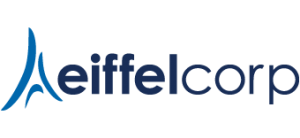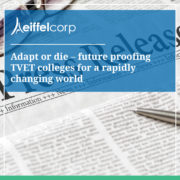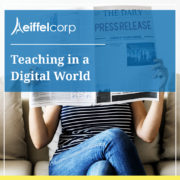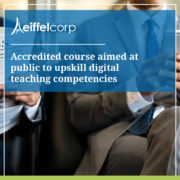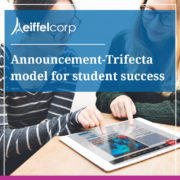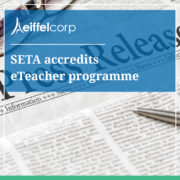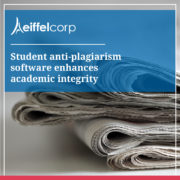
Adapt or die – future proofing TVET colleges for a rapidly changing world
Cape Town, 22 August 2018: In the face of the 4th industrial revolution and quickly evolving technology, unless South African TVET colleges, develop a technology plan, they will be irrelevant.
These challenging words by Myles Thies, Director of Digital Learning Services, Eiffel Corp at the IVETA conference 2018 held in Cape Town last week. Within the theme of the conference, “Making Technical and Vocational Education Training the First Choice’, Thies urged leaders in the sector to develop plans around technology to ensure they remain relevant in the current education and training environment which is already facing some significant headwinds
“Artificial Intelligence is going to revolutionise the job market and with TVETS being an essential part of education in South Africa, it’s vital for them to develop digital teaching strategies that meet the challenges,” said Thies.
“Over 800 000 students are enrolled at 50 TVET colleges on 264 campuses around the country and it’s imperative these students remain relevant. Graduates already face an uphill battle to find employment so they have to exit their courses with the ability to adapt to a changing work environment as quickly as possible,” he added.
While the 4th industrial revolution will potentially affect jobs, new jobs will replace traditional jobs and these will require a different skill set. TVET colleges will need to improve their way of imparting skills to students.
“Future learning is micro- and blended-learning and curriculums will be online. The workplace will be transformed and digital will be utilized to reskill staff.”
“Artificial Intelligence (AI) bots recently beat humans at the video game Dota 2. That’s a big deal, because their victory required teamwork and collaboration – a huge milestone in advancing artificial intelligence,” said Thies.
Although the AI bots played 183 years worth of the games before winning they did this and learned strategies quickly. Humans can’t hope to match this type of capability.
Robot automation is projected to take 800 million jobs by 2030*1. It’s estimated that the half-life of a job skill is about five years (every five years, that skill is about half as valuable as it was before).
Skilled workers thus need to get ahead of that decline in value.*2
Thies warned workers will be outpaced by AI and automation and the pace of innovation may be faster than the ability of workers to reskill.
With 35% of all jobs in South Africa, almost 5.7 million, currently at risk of total digital automation within a mere seven years, the country could see a crippling effect compounded by a fragile economy and growing unemployment.*3
TVETS also face competition in the form of international institutions offering digital education.
“Blended is the new black,” said Thies, “students and workers are seeking out programmes that combine localised face-to-face delivery with blended learning delivery options. Those institutions that get this mix right, with the right amount of quality and recognition, will have a winning recipe. Those institutions that fail to innovate delivery options will see a reduction in applications over time.
“The inclusion of technology for distribution and facilitation at a high level of quality is key, otherwise students will go elsewhere.”
Thies posed the questions – how will South Africa cope considering the massive challenges already faced in terms of skills, productivity and education? What do TVETS have to start doing now to be ready for the coming changes and challenges?
According to Thies, there are very few quick fixes, but he suggests:
1. Investment in technology
Making a serious and conscientious investment in technology is only one small part of the solution. Educator skills and capability to facilitate and impart skills in the technology dominated space has to be prioritised at every level. Continuous individual professional development and reskilling in digital teaching and assessment practices is essential.
Establishing a supportive technology and innovation ecosystem for all participants in the learning continuum.
2. Adaption
TVETS need to be adaptable in coping with technology and the new environment. Learners are seeking out new modes of learning based on their current use of technology, but educators are not at the level of digital teaching and learning to meet them, thereby forcing the TVET student to remain in a face-to-face teaching environment. Institutions need to embrace mobility.
3. Responsive
The ability and speed of adaptation must be robust enough to cope with the increasing pace of innovation. Teacher & lecturer skills are not keeping pace with innovation and capabilities.
4. Quality
Learners are more discerning and competition for TVET learners will be fierce (TVETS already play second fiddle to universities in SA.The TVET sector is trying to change this). Academic, facilitation and administrative quality have to be agile and flexible. Lecturers should be rewarded and recognised for digital teaching innovation. Baseline standards for digital teaching & learning that embrace course design and content standards are essential as well.
Source:
1 Quelle: OECD (2018), Survey of Adult Skills (PIAAC) 2112, 2015. Selection of OECD Countries. DW.com
2 World Economic Forum
3 Dr Rose Phillips, USB BS
Coverage:
http://scherlund.blogspot.com/2018/08/adapt-or-die-future-proofing-tvet.html
